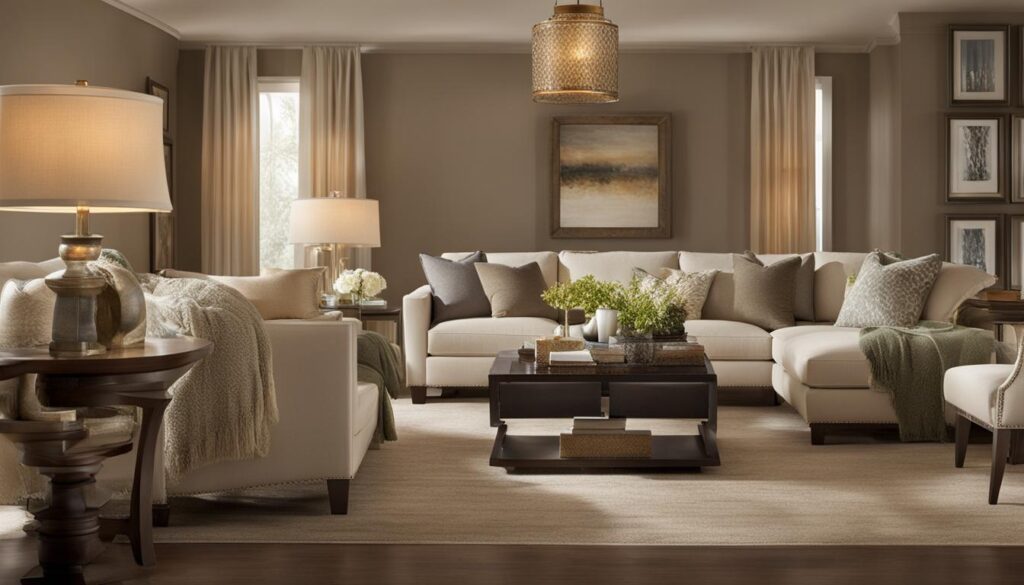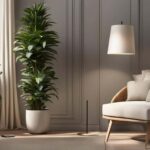Lighting plays a vital role in the design of a living room, and can lighting, also known as recessed lighting, has gained immense popularity in modern living spaces. Incorporating can lighting in the living room requires careful consideration of placement, customization options, and integration with other fixtures. It is essential to strike a balance in lighting, avoiding over-illumination, and utilizing dimmer switches for better control. Consistent spacing of the lights, adjusted based on the ceiling height and specific room needs, is crucial for optimal design. To ensure the best results, consulting a professional lighting designer can be beneficial. Furthermore, installing can lighting around the perimeter of the room, avoiding direct overhead placement and shadows, can enhance the overall ambiance. With a wide range of recessed lighting types and styles available, homeowners have endless options to match their home’s style and size.
Key Takeaways:
- Can lighting, or recessed lighting, is a popular choice for modern living room designs.
- Consider placement, customization options, and integration with other fixtures when incorporating can lighting in the living room.
- Avoid over-lighting by utilizing dimmer switches for better control.
- Consistent spacing of can lights is essential, considering ceiling height and specific room needs.
- Consulting a professional lighting designer can ensure optimal spacing and lighting design.
Table of Contents
The Pros and Cons of Recessed Lighting in Different Rooms of the House
When it comes to incorporating recessed lighting in different rooms of the house, it’s important to consider the purpose and specific needs of each space. While recessed lighting can be a great addition, it’s not always essential and can be substituted with other fixtures. Let’s explore the pros and cons of using recessed lighting in various rooms:
Kitchen
In the kitchen, recessed lighting is commonly used for task lighting, providing focused illumination for cooking and meal preparation. It can be combined with surface mount lighting to create a well-rounded lighting design. However, it’s important to note that recessed lighting in the kitchen is not essential and can be replaced with other fixtures such as pendant lights or under-cabinet lighting.
Mudroom
In the mudroom, the necessity for recessed lighting depends on the availability of other overhead lighting options. If there are sufficient overhead fixtures or natural light sources, recessed lighting may not be needed. However, if the room lacks adequate lighting, recessed lighting can be a practical addition to ensure visibility and functionality.
Living Room
In the living room, recessed lighting is usually not necessary, especially if there are ample overhead fixtures, sconces, and lamps present. The living room is a space where a combination of ambient, accent, and task lighting can create a cozy and inviting atmosphere. Instead of relying solely on recessed lighting, consider incorporating other lighting options that can provide a more versatile and layered lighting design.
Bedrooms
Bedrooms can benefit from a combination of different lighting sources. For example, semi-flush or chandelier lighting can be combined with recessed lighting to create a balanced and visually appealing atmosphere. The choice between using recessed lighting or not depends on the style of the house and personal preferences. It’s important to consider the overall lighting design and the desired ambiance for each bedroom.
Bathrooms
In bathrooms, the use of recessed lighting depends on personal preferences and the availability of other lighting sources. If there are well-placed sconces and surface mount lighting that provide sufficient light, recessed lighting may not be necessary. However, recessed lighting can be a practical addition, especially in larger bathrooms, to ensure even and adequate illumination.
It’s important to carefully consider the lighting needs of each room before deciding to incorporate recessed lighting. While it can provide a modern and clean look, it may not always be the best choice for every space. By understanding the pros and cons of recessed lighting in different rooms, homeowners can make informed decisions to create a well-lit and functional home.
The Importance of Lamps and Ambient Lighting in Interior Design
In interior design, lamps are not just functional lighting fixtures; they also play a crucial role in creating mood and ambiance in a room. Placing lamps on various surfaces can enhance the overall décor while providing warm and flattering light at eye level. These elements are vital for creating a welcoming and cozy atmosphere in a living room.
Ambient lighting, such as track lighting, pendant lighting, and wall lighting, adds depth and dimension to living spaces. These fixtures can be strategically placed to highlight specific areas or architectural features, creating visual interest and enhancing the overall design. For example, track lighting can be used to highlight artwork or decorative elements, while pendant lighting can add a touch of elegance and sophistication to a room.
“Lamps are not just lighting fixtures; they are essential design elements that can transform the mood and ambiance of a space.” – Interior Designer
Combining lamps with shades, sconces, and task lights allows for versatile lighting options and control over the mood of the room. This variety of lighting sources ensures that different lighting needs can be met at various times of the day or for different activities. For example, a combination of overhead track lighting and table lamps can provide both general and task lighting, making the living room a functional and inviting space for various activities, such as reading, entertaining, or watching TV.
When considering the lighting design for a living room, it is essential to strike a balance between functionality and aesthetics. The number and placement of lamps should be carefully considered to ensure optimal lighting coverage without overpowering or cluttering the space. By incorporating lamps and ambient lighting fixtures into the overall design, homeowners can create a well-lit and visually appealing living room that suits their personal style and enhances the comfort of the space.
Living Room Lighting Ideas
- Use a combination of table lamps and overhead track lighting for layered lighting.
- Consider pendant lighting to add a focal point and create a sense of drama.
- Utilize wall lighting to highlight architectural features or artwork.
- Ensure a balance between functional lighting and decorative fixtures for optimal design.
| Lighting Fixture | Function | Benefits |
|---|---|---|
| Table Lamps | Task lighting, ambient lighting | Provides adjustable light at eye level; enhances décor |
| Track Lighting | Ambient lighting, accent lighting | Offers flexibility in highlighting specific areas or objects |
| Pendant Lighting | Focal point, ambient lighting | Creates visual interest and adds a touch of elegance |
| Wall Lighting | Accent lighting, ambient lighting | Highlights architectural features or artwork |
Conclusion
The integration of can lighting, also known as recessed lighting, in the living room can greatly enhance both the functionality and ambiance of the space. However, it is crucial to carefully consider the specific needs of each room and find the right balance between recessed lighting and other lighting fixtures.
By hiring a professional lighting designer, homeowners can ensure optimal placement and spacing of the can lights, taking into account the ceiling height and the unique requirements of the room. This expertise is key in avoiding over-lighting the space and creating a harmonious lighting design.
In addition to can lighting, the use of lamps and other ambient lighting options plays a significant role in creating a warm and inviting atmosphere in the living room. Lamps provide flattering and filtered light at eye level, while track lighting, pendant lighting, and wall lighting add depth and dimension to the space.
Overall, by considering the purpose and style of each room, homeowners can make informed decisions about incorporating can lighting in their living spaces, leading to a well-designed and well-lit environment.
FAQ
Is recessed lighting necessary in the living room?
Recessed lighting is not essential in the living room if there is ample overhead lighting, sconces, and lamps present.
How should recessed lighting be spaced in the living room?
The spacing of recessed lighting should be consistent, taking into account the ceiling height and specific needs of the room.
Should recessed lighting be placed overhead in the living room?
It is advised to install recessed lighting around the perimeter of the room, avoiding direct overhead placement and shadows.
What types and styles of recessed lighting are available?
There are various types and styles of recessed lighting available, offering endless options for different home styles and sizes.
How can I create a warm and inviting atmosphere in the living room?
By combining lamps with shades, sconces, and task lights, you can create versatile lighting options and control over the mood of the room.
Do I need a professional lighting designer to install recessed lighting?
Hiring a professional lighting designer can ensure optimal spacing and lighting design when installing recessed lighting.
Can recessed lighting be used in other rooms besides the living room?
Recessed lighting can be used in various rooms, but its necessity depends on the availability of other overhead lighting options and personal preferences.
What is the role of lamps in interior design?
Lamps play a crucial role in creating mood and ambiance in interior design, providing flattering and filtered light at eye level.
How many lamps should I have in each room?
The number of lamps needed in each room depends on achieving a balance between functionality and aesthetics.


